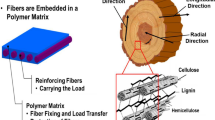Abstract
The potential of linear vibration friction as an innovative means of producing increases in both surface density and surface hardness was explored. The influence of processing pressure and time on the degree of surface densification, surface hardness and surface elasticity was investigated. It was found that surface hardness (measured as Brinell hardness) was positively correlated with densification ratio. Furthermore, surface elasticity, that is the ability of the surface to recover elastically after indentation during the Brinell hardness test, could be increased by up to 33% depending on the degree of surface densification. The temperature rise due to friction was also studied. During processing, it was found that the temperature rise on both the radial and tangential surfaces was positively correlated with the processing pressure and time.






Similar content being viewed by others
References
Blomberg J, Persson B, Blomberg A (2005) Effects of semi-isostatic densification of wood on the variation in strength properties with density. Wood Sci Technol 39:339–350
Dwianto W, Norimoto M, Morooka T, Tanaka F, Inoue M, Liu Y (1998) Radial compression of sugi wood (Cryptomeria japonica D. Don). Holz Roh Werkst 56:403–411
EN 1534 (2000) Wood and parquet flooring—determination of resistance to indentation (Brinell)—Test method
Gfeller B, Properzi M, Zanetti M, Pizzi A, Pichelin F, Lehmann M, Delmotte L (2004) Wood bonding by mechanically induced in situ welding of polymeric structural wood constituents. J Appl Polym Sci 92:243–251
Gfeller B, Zanetti M, Properzi M, Pizzi A, Pichelin F, Lehmann M, Delmotte L (2003) Wood bonding by vibrational welding. J Adhesion Sci Technol 17(11):1570–1589
Gindl W, Hansmann C, Gierlinger N, Schwanninger M, Hinterstoisser B, Jeronimidis G (2004) Using a water-soluble melamine-formaldehyde resin to improve the hardness of Norway spruce wood. J Appl Polym Sci 93:1900–1907
Hirata S, Ohta M, Honma Y (2001) Hardness distribution on wood surface. J Wood Sci 47:1–7
Ito Y, Tanahashi M, Shigematsu M, Shinoda Y, Ohta C (1998) Compressive-molding of wood by high-pressure steam-treatment: Part1. Development of compressively molded squares from thinnings. Holzforschung 52:211–216
JIS Z 2101 (1994) Methods of test for woods. Japanese Industrial Standard
Navi P, Gigardet F (2000) Effects of thermo-hydro mechanical treatment on the structure and properties of wood. Holzforschung 54:287–293
Niemz P, Stübi T (2000) Investigations of hardness measurements on wood based materials using a new universal measurement system. Proceedings of the symposium on wood machining, properties of wood and wood composites related to wood machining. Vienna, pp 51–61
Pizzi A, Leban J-M, Zanetti M, Pichelin F, Wieland S, Properzi M (2005) Surface finishes by mechanically induced wood surface fusion. Holz Roh Werkst 63:251–255
Salmén L (1984) Viscoelastic properties of in situ lignin under water-saturated conditions. J Mater Sci 19:3090–3096
Uhmeir A, Morooka T, Norimoto M (1998) Influence of thermal softening and degradation on the radial compression behavior of wet spruce. Holzforschung 52:77–81
Zhang Y, Zhang SY, Chui YH, Wan H, Bousmina M (2006) Wood plastic composites by melt impregnation: polymer retention and hardness. J Appl Polym Sci 102:1672–1680
Author information
Authors and Affiliations
Corresponding author
Rights and permissions
About this article
Cite this article
Rautkari, L., Properzi, M., Pichelin, F. et al. Surface modification of wood using friction. Wood Sci Technol 43, 291–299 (2009). https://doi.org/10.1007/s00226-008-0227-0
Received:
Published:
Issue Date:
DOI: https://doi.org/10.1007/s00226-008-0227-0




